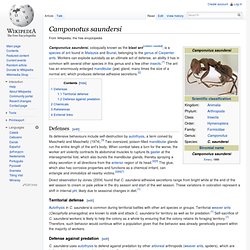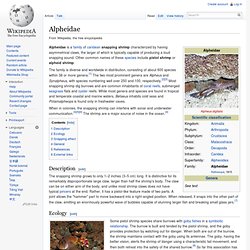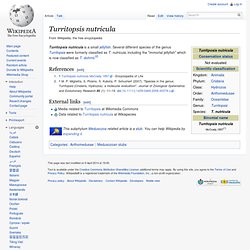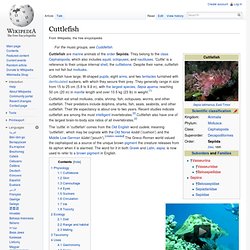

Camponotus saundersi. Camponotus saundersi, coloquially known as the blast ant[citation needed], is a species of ant found in Malaysia and Brunei, belonging to the genus of Carpenter ants.

Workers can explode suicidally as an ultimate act of defense, an ability it has in common with several other species in this genus and a few other insects.[1] The ant has an enormously enlarged mandibular (jaw) gland, many times the size of a normal ant, which produces defense adhesive secretions.[2] Defenses[edit] Direct observation by Jones (2004) found that C. saundersi adhesive secretions range from bright white at the end of the wet season to cream or pale yellow in the dry season and start of the wet season. These variations in coloration represent a shift in internal pH, likely due to seasonal changes in diet.[1] Territorial defense[edit] Autothysis in C. saundersi is common during territorial battles with other ant species or groups.
Defense against predation[edit] 1. 2. Mantis shrimp. Called "sea locusts" by ancient Assyrians, "prawn killers" in Australia and now sometimes referred to as "thumb splitters" – because of the animal's ability to inflict painful gashes if handled incautiously[4] – mantis shrimp sport powerful claws that they use to attack and kill prey by spearing, stunning, or dismemberment.

Although it only happens rarely, some larger species of mantis shrimp are capable of breaking through aquarium glass with a single strike from this weapon.[5] Ecology[edit] These aggressive and typically solitary sea creatures spend most of their time hiding in rock formations or burrowing intricate passageways in the sea bed. They either wait for prey to chance upon them or, unlike most crustaceans, at times they hunt, chase, and kill prey. They rarely exit their homes except to feed and relocate, and can be diurnal, nocturnal, or crepuscular, depending on the species.
Classification and the claw[edit] Mantis shrimp from the front. Alpheidae. The family is diverse and worldwide in distribution, consisting of about 600 species within 38 or more genera.[1] The two most prominent genera are Alpheus and Synalpheus, with species numbering well over 250 and 100, respectively.[2][3] Most snapping shrimp dig burrows and are common inhabitants of coral reefs, submerged seagrass flats and oyster reefs.

While most genera and species are found in tropical and temperate coastal and marine waters, Betaeus inhabits cold seas and Potamalpheops is found only in freshwater caves. When in colonies, the snapping shrimp can interfere with sonar and underwater communication.[4][5][6] The shrimp are a major source of noise in the ocean.[4] Description[edit] Ecology[edit] Some pistol shrimp species share burrows with goby fishes in a symbiotic relationship. Social behavior has been discovered in the genus Synalpheus. Pistol shrimp have also been noted for their ability to reverse claws. Turritopsis nutricula. Turritopsis nutricula is a small jellyfish.

Several different species of the genus Turritopsis were formerly classified as T. nutricula, including the "immortal jellyfish" which is now classified as T. dohrnii.[2] References[edit] External links[edit] Media related to Turritopsis at Wikimedia Commons Data related to Turritopsis nutricula at Wikispecies. Tardigrade. Tardigrades (also known as waterbears or moss piglets)[2][3][4] are water-dwelling, segmented micro-animals, with eight legs.[2] They were first described by the German pastor Johann August Ephraim Goeze in 1773.

The name Tardigrada (meaning "slow stepper") was given three years later by the Italian biologist Lazzaro Spallanzani.[5] Since 1778, over 1,150 tardigrade species have been identified. Tardigrades are classified as extremophiles, organisms that can thrive in a physically or geochemically extreme condition that would be detrimental to most life on Earth.[6][7][3] For example, tardigrades can withstand temperatures from just above absolute zero to well above the boiling point of water, pressures about six times greater than those found in the deepest ocean trenches, ionizing radiation at doses hundreds of times higher than the lethal dose for a human, and the vacuum of outer space. Tardigrades form the phylum Tardigrada, part of the superphylum Ecdysozoa.
Cuttlefish. Cuttlefish eat small mollusks, crabs, shrimp, fish, octopuses, worms, and other cuttlefish.

Their predators include dolphins, sharks, fish, seals, seabirds, and other cuttlefish. Their life expectancy is about one to two years. Recent studies indicate cuttlefish are among the most intelligent invertebrates.[2] Cuttlefish also have one of the largest brain-to-body size ratios of all invertebrates.[2] Video of a cuttlefish in its natural habitat Physiology[edit] Cuttlebone[edit] A cuttlefish possesses an internal structure called the cuttlebone, which is porous and is made of aragonite. This broadclub cuttlefish (Sepia latimanus) can go from camouflage tans and browns (top) to yellow with dark highlights (bottom) in less than a second.